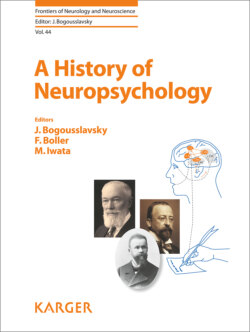Читать книгу A History of Neuropsychology - Группа авторов - Страница 27
На сайте Литреса книга снята с продажи.
Further Developments
ОглавлениеSince the 1950s, and at an accelerating pace, have come ever deeper analyses of cerebral specialization stemming from advances in virtually every facet of neuropsychological science: the development and adoption of standardized tests of the aphasias, agnosias, and other neuro-cognitive as well as neuro-affective disorders; the incorporation of theory and research in cognitive science, including the study of memory, perception, attention, problem-solving, and executive control; large-scale studies, many of war veterans, comparing left- and right-hemisphere injuries; and, using such new electrophysiological and imaging methods as ERP, PET, MRI, fMRI, MEG, and SPECT, vast improvements in measuring structure and function in clinical and non-clinical populations, and with DTI (diffusion tensor imaging), in providing new details on connectivity through in vivo delineation of white-matter tracts. Along with these advances have come studies of the development of cerebral specialization; of the corpus callosum and the effects of its surgical separation; of the effects of side, time, and type of injury on function; and of the relation between cerebral specialization and a host of variables, including sex, handedness (degree as well as direction), intelligence, culture, literacy, and special talents and disabilities. Still other studies are focusing on cerebral specialization in other species; its embryological, anatomical, hormonal, genetic, and evolutionary foundations; and, ultimately, its benefits for the individual and the species. The outcome is that much progress has been made and many lessons learned. To name just a few examples: Broca was correct: a “small number” of persons do “speak with the right hemisphere,” and there is indeed no necessary coincidence between them and left-handers, the majority of whom, like nearly all right-handers, speak with the left (Harris [60]); Broca’s region, however, is found to have a broader range of language-related functions than speech-production [61]. Developmental studies also reveal hemispheric differences in motor and cognitive functions in infancy and even well before birth (e.g., [62, 63]), and methods such as DTI are revealing promising clues to the origins of cerebral specialization in the form of hemispheric differences in macro- and microscopic structural organization (e.g., [62]; see also [64]). New research also suggests an important benefit of a lateralized brain: greater processing efficiency [65], which makes more understandable why cerebral specialization is increasingly found to be a species-wide characteristic in vertebrates [66] as well as invertebrates [67]. Along with these examples, more general descriptions of cerebral specialization are being sought; one sees the left as specialized for well-learned action sequences, the right for detecting and responding to unexpected, behaviorally relevant stimuli in the environment [68]. And as a last and especially telling example, “faculties” are no longer regarded as complete in themselves and wholly lateralized to either side. Consider language and music: as noted by Patel [69], although languages have nouns and verbs, grammatical categories with no analogues in music, they have other features in common and are served by both hemispheres, each taking the lead for certain ones. As summarized by Peretz et al. [70], the left leads for pitch (tone) intervals, rhythm and timing (temporal order), sequencing, and perception of duration; the right for tonal patterns, melody, timbre, and emotion. And instead of modularity, with each feature, or function, uniquely associated with an anatomically distinct region, they are organized into cortical as well as sub-cortical neural networks (a so-called distributive-processing model), some working in parallel, others overlapping. Progress has not always been fast or smooth: for instance, the terms “major,” “minor,” and “cerebral dominance” in its original sense were not abandoned until the 1970s; and we still await definitive explanations of cerebral specialization. Some past lessons also may need re-emphasis lest they be forgotten. For one, despite Wernicke’s warning against diagnosing fluent aphasia as psychosis, the error evidently occurs often enough to warrant mention in the psychiatric literature (e.g., [71, 72]). For another, the power of neuroimaging to pinpoint damage in injured brains and to identify activated regions under different cognitive and emotional conditions runs the risk of “over-localizing” and thus neglecting Hughlings-Jackson’s maxim about localizing symptoms versus localizing functions. These matters aside, the study of cerebral specialization has come a long way since its beginning, and, looking back, we can thank our predecessors for starting us on a challenging but rewarding scientific journey. Like all such journeys, it is far from over.
